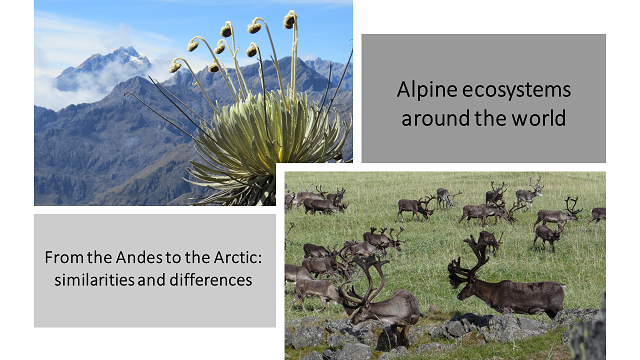GMBA webinar - Alpine ecosystems around the world: similarities and differences

Date: Tuesday 22 August 2023, 2pm CEST
Speakers: Nigel Yoccoz, Laszlo Nagy, and Fransisco Cuesta
During this webinar, Nigel Yoccoz, Laszlo Nagy, and Fransisco Cuesta shed light on similarities and differences in alpine ecosystems across the world's mountains.
Perspective I - the Arctic: Alpine ecosystems are characterized by low temperatures, and their elevational distribution is therefore partly linked to latitude. As many mountain ranges reach into the Arctic, it means that there is no sharp limit between what has been called Arctic and alpine vegetation, and this is exemplified by many “arctic-alpine” plant distributions. On the contrary, many mammal and bird distributions are disjunct – i.e. they are either alpine or arctic – consider for example emblematic “Arctic” species such as reindeer, muskox, Arctic fox, Snowy owl or snow bunting versus “alpine” species such as chamois, ibex, marmots, snowfinch or alpine chough. Nigel Yoccoz from the Arctic University of Norway will discuss some of the climatic and historical factors that can explain the difference between plants and higher vertebrates, in particular differences in terms of snow conditions.
Perspective II - the Andes: The Andes stretches over more than 60 degrees of latitude, running from north to south, crossing macroclimatic and biogeographic boundaries. Today’s montane and alpine landscapes and vegetation bear witness to historic and recent land use. How climate change and socio-economic drivers may further shape Andean alpine biodiversity and ecosystems has attracted much attention. Laszlo Nagy and Fransisco Cuesta from the University of Campinas (Brazil) and the University of the Americas (Ecuador), respectively, will present a brief historic panorama and recent trends in Andean alpine biodiversity.
